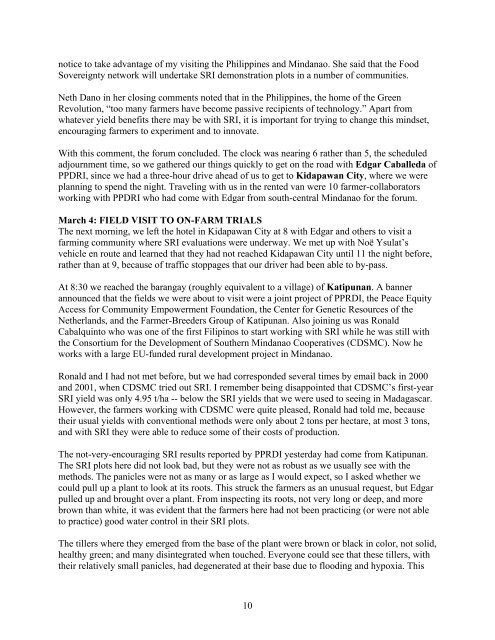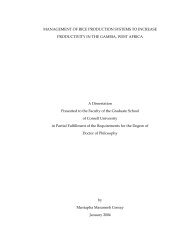report on a visit to the philippines to review sri progress
report on a visit to the philippines to review sri progress
report on a visit to the philippines to review sri progress
Create successful ePaper yourself
Turn your PDF publications into a flip-book with our unique Google optimized e-Paper software.
notice <strong>to</strong> take advantage of my <strong>visit</strong>ing <strong>the</strong> Philippines and Mindanao. She said that <strong>the</strong> Food<br />
Sovereignty network will undertake SRI dem<strong>on</strong>strati<strong>on</strong> plots in a number of communities.<br />
Neth Dano in her closing comments noted that in <strong>the</strong> Philippines, <strong>the</strong> home of <strong>the</strong> Green<br />
Revoluti<strong>on</strong>, “<strong>to</strong>o many farmers have become passive recipients of technology.” Apart from<br />
whatever yield benefits <strong>the</strong>re may be with SRI, it is important for trying <strong>to</strong> change this mindset,<br />
encouraging farmers <strong>to</strong> experiment and <strong>to</strong> innovate.<br />
With this comment, <strong>the</strong> forum c<strong>on</strong>cluded. The clock was nearing 6 ra<strong>the</strong>r than 5, <strong>the</strong> scheduled<br />
adjournment time, so we ga<strong>the</strong>red our things quickly <strong>to</strong> get <strong>on</strong> <strong>the</strong> road with Edgar Caballeda of<br />
PPDRI, since we had a three-hour drive ahead of us <strong>to</strong> get <strong>to</strong> Kidapawan City, where we were<br />
planning <strong>to</strong> spend <strong>the</strong> night. Traveling with us in <strong>the</strong> rented van were 10 farmer-collabora<strong>to</strong>rs<br />
working with PPDRI who had come with Edgar from south-central Mindanao for <strong>the</strong> forum.<br />
March 4: FIELD VISIT TO ON-FARM TRIALS<br />
The next morning, we left <strong>the</strong> hotel in Kidapawan City at 8 with Edgar and o<strong>the</strong>rs <strong>to</strong> <strong>visit</strong> a<br />
farming community where SRI evaluati<strong>on</strong>s were underway. We met up with Noë Ysulat’s<br />
vehicle en route and learned that <strong>the</strong>y had not reached Kidapawan City until 11 <strong>the</strong> night before,<br />
ra<strong>the</strong>r than at 9, because of traffic s<strong>to</strong>ppages that our driver had been able <strong>to</strong> by-pass.<br />
At 8:30 we reached <strong>the</strong> barangay (roughly equivalent <strong>to</strong> a village) of Katipunan. A banner<br />
announced that <strong>the</strong> fields we were about <strong>to</strong> <strong>visit</strong> were a joint project of PPRDI, <strong>the</strong> Peace Equity<br />
Access for Community Empowerment Foundati<strong>on</strong>, <strong>the</strong> Center for Genetic Resources of <strong>the</strong><br />
Ne<strong>the</strong>rlands, and <strong>the</strong> Farmer-Breeders Group of Katipunan. Also joining us was R<strong>on</strong>ald<br />
Cabalquin<strong>to</strong> who was <strong>on</strong>e of <strong>the</strong> first Filipinos <strong>to</strong> start working with SRI while he was still with<br />
<strong>the</strong> C<strong>on</strong>sortium for <strong>the</strong> Development of Sou<strong>the</strong>rn Mindanao Cooperatives (CDSMC). Now he<br />
works with a large EU-funded rural development project in Mindanao.<br />
R<strong>on</strong>ald and I had not met before, but we had corresp<strong>on</strong>ded several times by email back in 2000<br />
and 2001, when CDSMC tried out SRI. I remember being disappointed that CDSMC’s first-year<br />
SRI yield was <strong>on</strong>ly 4.95 t/ha -- below <strong>the</strong> SRI yields that we were used <strong>to</strong> seeing in Madagascar.<br />
However, <strong>the</strong> farmers working with CDSMC were quite pleased, R<strong>on</strong>ald had <strong>to</strong>ld me, because<br />
<strong>the</strong>ir usual yields with c<strong>on</strong>venti<strong>on</strong>al methods were <strong>on</strong>ly about 2 t<strong>on</strong>s per hectare, at most 3 t<strong>on</strong>s,<br />
and with SRI <strong>the</strong>y were able <strong>to</strong> reduce some of <strong>the</strong>ir costs of producti<strong>on</strong>.<br />
The not-very-encouraging SRI results <str<strong>on</strong>g>report</str<strong>on</strong>g>ed by PPRDI yesterday had come from Katipunan.<br />
The SRI plots here did not look bad, but <strong>the</strong>y were not as robust as we usually see with <strong>the</strong><br />
methods. The panicles were not as many or as large as I would expect, so I asked whe<strong>the</strong>r we<br />
could pull up a plant <strong>to</strong> look at its roots. This struck <strong>the</strong> farmers as an unusual request, but Edgar<br />
pulled up and brought over a plant. From inspecting its roots, not very l<strong>on</strong>g or deep, and more<br />
brown than white, it was evident that <strong>the</strong> farmers here had not been practicing (or were not able<br />
<strong>to</strong> practice) good water c<strong>on</strong>trol in <strong>the</strong>ir SRI plots.<br />
The tillers where <strong>the</strong>y emerged from <strong>the</strong> base of <strong>the</strong> plant were brown or black in color, not solid,<br />
healthy green; and many disintegrated when <strong>to</strong>uched. Every<strong>on</strong>e could see that <strong>the</strong>se tillers, with<br />
<strong>the</strong>ir relatively small panicles, had degenerated at <strong>the</strong>ir base due <strong>to</strong> flooding and hypoxia. This<br />
10

















